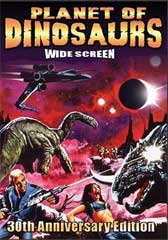 PLANET
OF DINOSAURS (1978)
PLANET
OF DINOSAURS (1978)Director: James K. Shea
Retromedia/Infinity Entertainment
 PLANET
OF DINOSAURS (1978)
PLANET
OF DINOSAURS (1978)The cinematic magic and wizardry
of Willis O'Brien and Ray Harryhausen inspired a number of young monster movie
fans to dabble in the art of stop motion effects. Some of these individuals
went on to have very successful, long-lasting careers in this field, while films
such as EQUINOX, FLESH GORDON and LASERBLAST are good showcases of just some
of the talent at hand. Like those three movies, 1978's PLANET OF DINOSAURS was
another independent (produced outside the studio system) effort, obviously paying
homage to the grand Harryhausen creature fantasies which proceeded it. Extremely
low budget (the way we like 'em!) this effects-driven sci-fi adventure actually
won the "Science Fiction Film Award" for its stop-motion monster designs.
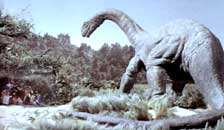 Due to a malfunction, a spacecraft is forced to land in a body of water of an
unknown planet. After the first causality, a busty communications officer (Mary
Appleseth), succumbs to an underwater reptilian creature, the remaining crew
comes to the conclusion that the planet may not be as peaceful as it looks.
The obnoxious "boss" Harvey (Harvey Shain), the commanding officer
Lee (Louie Lawless) and the no-nonsense, sensible Jim (James Whitworth, "Papa
Jupiter" from THE HILLS HAVE EYES) all try and run things their own way
as they encounter a number of prehistoric creatures, including a Tyrannosaurus
Rex, a Stegosaurus, a Brontosaurus, a Policanthus and a menacing oversized spider.
The other members of the crew (Pamela Bottaro, Charlotte Speer, Chuck Pennington,
Derna Wylde and Max Thayer, the latter the star of ILSA, HAREM KEEPER OF THE
OIL SHEIKS) fight for survival against the mammoth threats thrown upon them,
as well as ponder whether or not they'll ever make it back to their home planet.
Due to a malfunction, a spacecraft is forced to land in a body of water of an
unknown planet. After the first causality, a busty communications officer (Mary
Appleseth), succumbs to an underwater reptilian creature, the remaining crew
comes to the conclusion that the planet may not be as peaceful as it looks.
The obnoxious "boss" Harvey (Harvey Shain), the commanding officer
Lee (Louie Lawless) and the no-nonsense, sensible Jim (James Whitworth, "Papa
Jupiter" from THE HILLS HAVE EYES) all try and run things their own way
as they encounter a number of prehistoric creatures, including a Tyrannosaurus
Rex, a Stegosaurus, a Brontosaurus, a Policanthus and a menacing oversized spider.
The other members of the crew (Pamela Bottaro, Charlotte Speer, Chuck Pennington,
Derna Wylde and Max Thayer, the latter the star of ILSA, HAREM KEEPER OF THE
OIL SHEIKS) fight for survival against the mammoth threats thrown upon them,
as well as ponder whether or not they'll ever make it back to their home planet.
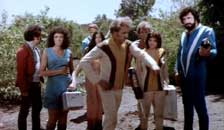 Featuring
actors sporting bushy hair and mustaches (many viewers have made comparisons
to porno performers), colored jumpsuits doubling as futuristic space-wear, overall
clumsy acting, a grating synth score and an spaceship interior which looks like
it was built in some neighbor's garage, PLANET OF DINOSAURS can't hide its bargain
basement production values. Shot mostly on location with some very scenic natural
California locations, the film has gained a reputable following because of its
excellent stop-motion dinosaur effects, which come very close to what we've
seen in much higher budgeted, higher-profiled big studio endeavors (the matting
work here is credited to the great Jim Danforth). Most impressive is the T-
Rex, though all the dinos look great, and this humble little effort also makes
homages to 20 MILLION MILES TO EARTH and THE BEAST FROM 20,000 FATHOMS during
its proceedings. A mix of no-budget sci-fi action and very impressive animated
monsters, PLANET OF DINOSAURS is a must for stop-motion enthusiasts, and those
allured by "bad" movies will also want to give this one a stab.
Featuring
actors sporting bushy hair and mustaches (many viewers have made comparisons
to porno performers), colored jumpsuits doubling as futuristic space-wear, overall
clumsy acting, a grating synth score and an spaceship interior which looks like
it was built in some neighbor's garage, PLANET OF DINOSAURS can't hide its bargain
basement production values. Shot mostly on location with some very scenic natural
California locations, the film has gained a reputable following because of its
excellent stop-motion dinosaur effects, which come very close to what we've
seen in much higher budgeted, higher-profiled big studio endeavors (the matting
work here is credited to the great Jim Danforth). Most impressive is the T-
Rex, though all the dinos look great, and this humble little effort also makes
homages to 20 MILLION MILES TO EARTH and THE BEAST FROM 20,000 FATHOMS during
its proceedings. A mix of no-budget sci-fi action and very impressive animated
monsters, PLANET OF DINOSAURS is a must for stop-motion enthusiasts, and those
allured by "bad" movies will also want to give this one a stab.
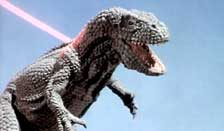 A staple of budget label VHS and DVD companies, PLANET OF DINOSAURS has finally
been given an official digital release, with this 30th Anniversary Edition (though
the cover mistakenly states "20th") from Retromedia, now being distributed
by Infinity Entertainment. An onscreen notice before the film warns that the
film was mastered from different 35mm and 16mm sources, as the original materials
are no longer in presentable condition. The transfer does exhibit some lines,
splashes of blotches, and muted colors on several occasions, but all in all,
the presentation is very watchable, with decent colors, good picture detail,
and only occasional grain. The film has been presented anamorphic in its original
1.85:1 ratio, and the framing looks proper throughout. The mono audio is also
fairly clean, with no noticeable problematic issues.
A staple of budget label VHS and DVD companies, PLANET OF DINOSAURS has finally
been given an official digital release, with this 30th Anniversary Edition (though
the cover mistakenly states "20th") from Retromedia, now being distributed
by Infinity Entertainment. An onscreen notice before the film warns that the
film was mastered from different 35mm and 16mm sources, as the original materials
are no longer in presentable condition. The transfer does exhibit some lines,
splashes of blotches, and muted colors on several occasions, but all in all,
the presentation is very watchable, with decent colors, good picture detail,
and only occasional grain. The film has been presented anamorphic in its original
1.85:1 ratio, and the framing looks proper throughout. The mono audio is also
fairly clean, with no noticeable problematic issues.
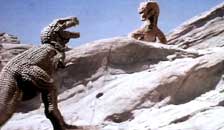 The
disc features a commentary with director James K. Shea and FX artists Doug Beswick,
Steve Czerkas and Jim Aupperle. Nicely moderated by Retromedia-head Fred Olen
Ray, the commentary is very informative and enjoyable, touching upon how the
film came to be, the actors involved, the script, the locations, and most predominately,
the special effects, which are discussed here in great detail. Rounding out
the extras are two original TV spots for the film, as well as two silent-era
animation shorts from Willis O'Brien: "Ghost of Slumber Mountain"
(1918) and "Dinosaur and the Missing Link" (1915). (George
R. Reis)
The
disc features a commentary with director James K. Shea and FX artists Doug Beswick,
Steve Czerkas and Jim Aupperle. Nicely moderated by Retromedia-head Fred Olen
Ray, the commentary is very informative and enjoyable, touching upon how the
film came to be, the actors involved, the script, the locations, and most predominately,
the special effects, which are discussed here in great detail. Rounding out
the extras are two original TV spots for the film, as well as two silent-era
animation shorts from Willis O'Brien: "Ghost of Slumber Mountain"
(1918) and "Dinosaur and the Missing Link" (1915). (George
R. Reis)